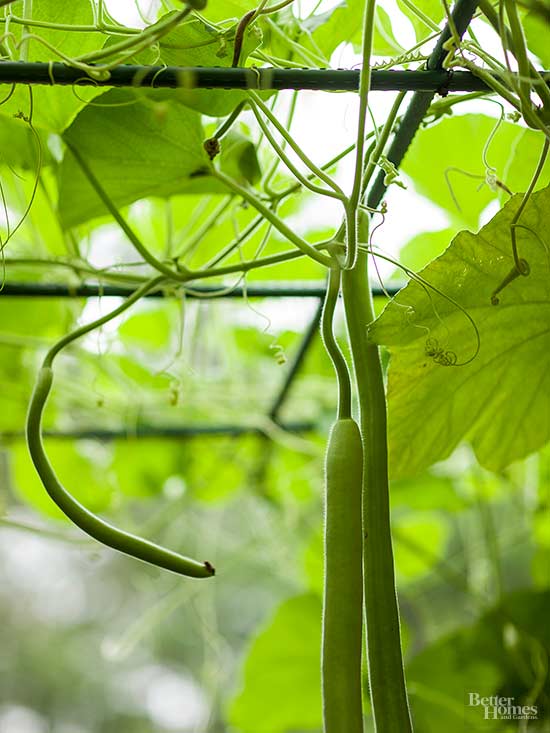






Perhaps the biggest challenge in growing beans is deciding which ones to plant! Many people love to grow green beans (also called snap beans, and they come in a variety of colors besides green) to be cooked and eaten shortly after harvest, although they can be frozen or canned for later use. Shelling or dry beans are an easy way to grow food that you can store for cooking later. The bean roll call includes black, black-eyed pea, broad, butter, chickpea (garbanzo), cowpea, kidney, fava, Great Northern, lima, navy, pinto, red, string, and many more. Choose the ones you and your family like best.
Choose what size of bean plants you want to grow: bush beans or pole beans.
Bush beans are the most popular type to grow. They produce fresh pods that make a snapping sound when you break them into pieces. Although bush beans take more space, they need less staking, weeding, and watering. They produce most of their crop at one time, although bush bean plants kept picked generally will continue flowering and producing some vegetables throughout the summer. To keep a consistent crop of bush beans growing, plant every two weeks throughout the summer.
Pole beans are a good solution for growing beans in a smaller space. Plant beans up a 5- to 8-foot trellis or pyramid tuteur to support the long vines. Each green bean plant yields two to three times more beans than bush beans but only a few at a time.
Shelling or dry beans also come in bush and pole varieties.
continue reading belowStarting bean seeds: Start growing beans from seed. Bean plants don't like to be transplanted. For best production, place all bean plants in a location that gets at least 8 hours of sun a day.
Follow directions on your seed packet for how deep and how far apart to plant your seeds. If you garden with kids, teach them how to plant beans; the seeds are large enough for young children to handle.
Beans do not survive frost. Wait to plant beans until danger of frost is past and the soil is warm. Cover plants anytime freezing temperatures are forecast.
Watering beans: Once bean plants sprout, they should get about 1/2 to 1 inch of water per week in the form of rain or supplemental water. Space plants far enough apart for good air circulation. Avoid overhead sprinkling, if possible, to ward off mildew and fungus problems; use drip irrigation instead.
Fertilizing beans: You don't need to fertilize bean plants. Especially avoid using nitrogen fertilizer, which promotes plant growth over production of bean pods. If you feel you must use fertilizer, choose one with a smaller first number of the NPK (nitrogen, phosphorus, potassium) numbers on the container, such as 5-10-10.
Keep bean plants well weeded so they're not competing for nutrients and moisture. Pull weeds when they're small; if the weed is allowed to grow large, pulling it can also uproot the bean plant.
Harvesting beans: Harvest snap beans when the pods are relatively small, usually between 1/8 and 1/4 inch wide.
Harvest dry or shelling beans late in the growing season when the pods clearly show the bean seeds inside. The pods should be allowed to dry on the plant until just before frost. If the beans are mature but not dry, simply pull out the plants and hang them in a warm, dry place. Once dried, the beans can be removed from their pods and stored for later use.
Copyright © www.100flowers.win Botanic Garden All Rights Reserved